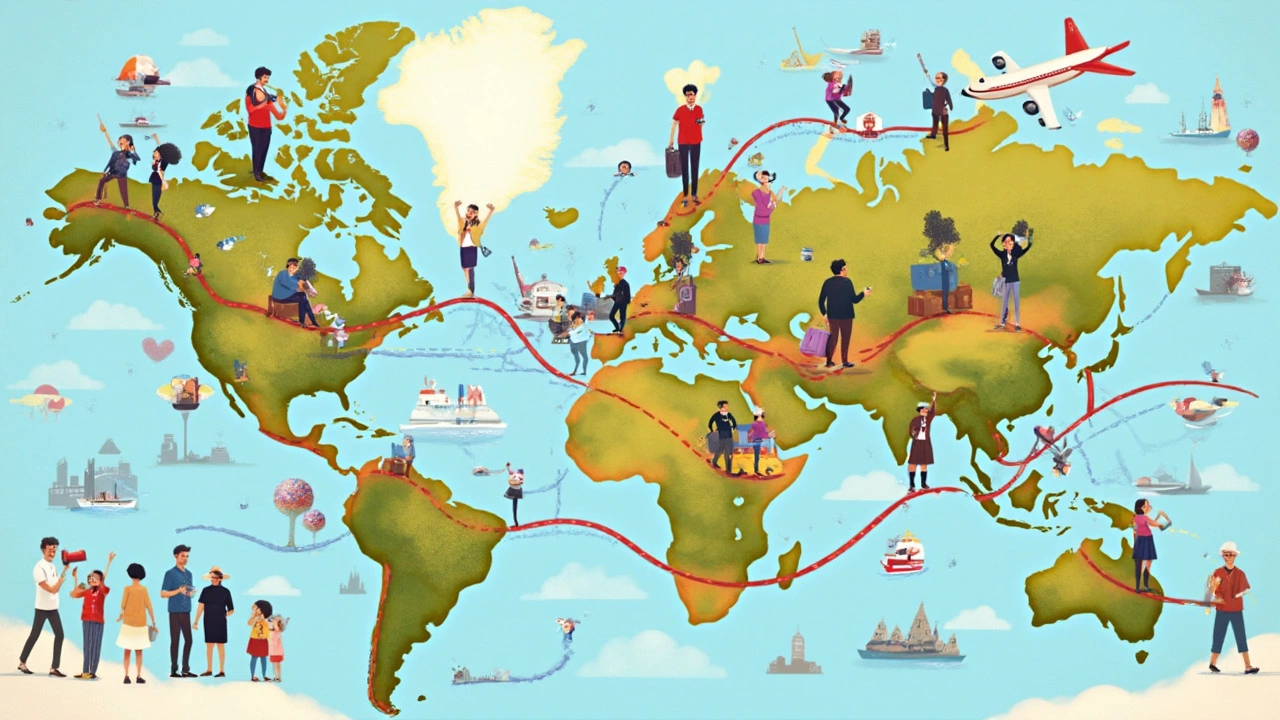Ever sat at an airport and tried to guess which age group is most likely to be hopping on planes every month? Some folks think the world belongs to twenty-somethings with backpacks; others swear seasoned retirees keep cruises afloat. Data tells a different story. Numbers reveal surprising shifts—like how Gen Z is redefining bucket-list trips and why millennials seem to live at airports this decade. Let’s crack open the world’s travel diary and figure out who’s really racking up those frequent flyer miles.
The Numbers: Breaking Down Travel by Age Group
Let’s get real about the stats. According to the United Nations World Tourism Organization’s 2024 Global Travel Report, people ages 25-34 travel more than any other age bracket right now. This chunk of young professionals makes up about 27% of all global trips, squeezing in long weekends, remote work getaways, weddings, and just-for-fun escapes. Millennials, now mostly in their late twenties and early thirties, are sometimes called the ‘travel generation.’ Digital nomadism? That’s millennial territory. A Forbes study from March 2025 showed that 65% of millennials prioritized travel over big purchases like cars or fancy tech.
Travel statistics by age paint a neat pattern. Baby boomers (age 60+) still pack cruise ships and flock to group tours but make up only about 18% of leisure travelers worldwide. Meanwhile, Gen Z (ages 18-24) seems always on the move—think gap years, internships abroad, or Instagram-fueled jaunts—yet many are limited by school or budgets. These under-25s make up roughly 20% of trips, but that number has shot up since 2020, as remote learning and work have erased some barriers.
The 35-54 bracket (Gen X and younger boomers) is a powerhouse too, especially for family and business trips. They book slightly longer getaways than younger counterparts, and according to Expedia’s 2025 survey, they control 32% of total travel spend, even if their trip count doesn’t top millennials. It’s partly because families spend more per trip and tend to travel during school breaks, like summer or Christmas. The big surprise? Empty nesters aged 55-64 now take more frequent, shorter solo trips, especially in Europe and North America, than ever before. That’s a pandemic aftereffect: delayed retirement plans pushed this group to travel more aggressively in 2022-2025, catching up on lost time.
So, in raw numbers, millennials (25-34) still take the most trips, with Gen Z nipping at their heels and Gen X leading the dollars-spent race. But travel is not just about quantity—it’s also about the way these groups move, how often, and why.
Why Millennials and Gen Z Travel So Much
There’s no single answer, but technology and work culture play huge roles. Millennials grew up when airfare dropped, budget airlines exploded, and the world shrunk dramatically. Couchsurfing, Airbnbs, last-minute booking apps—these became standard tools during their twenties. In fact, Booking.com’s 2024 research says 78% of millennial travelers use at least 3 travel apps before departure. They stack business with leisure (“bleisure”), take long weekends at coworking hotels, and value experiences more than stuff.
Social media is another biggie. Instagram and TikTok aren’t just for snapping pretty beaches or croissants—they drive entire industries. Destinations once considered off-the-radar, like Albania, Colombia, or Vietnam’s lesser-known islands, are suddenly hot spots because Gen Zers spot them on their feeds. Research from the Adventure Travel Trade Association in late 2024 says 58% of travelers under 35 picked their last destination after seeing it online, not from a traditional guidebook or ad.
Pandemic habits stuck, too. Once people realized they could work from almost anywhere with Wi-Fi, travel frequency jumped. More millennials, and even Gen Z interns, are snagging remote gigs that let them explore the world. Plus, with no kids tying them down, it’s easier for these groups to skip out midweek or switch cities monthly. That flexibility is gold. The cost of travel is more manageable, too: budget flights, hostels, group tours, travel credits on credit cards—these let young people visit places their parents only dreamed of. Millennial and Gen Z travelers are masters of travel hacking, using every point, hack, and fare drop alert to maximize trips.
Peer connections matter. The group-trip surge—think birthday getaways, friendcations, destination bachelorette parties—crosses continents. If you’re targeting the most travel-obsessed age group for advice, tune into what’s trending on TikTok and Instagram. Travel companies set their sights on these app-happy cohorts with tailored deals, gamified booking experiences, and influencer marketing. The era when only retirees had time for bucket lists is gone. Today, anyone with a remote job and a FOMO scroll is packing their bags.

Travel Habits Shift by Age: What Each Group Loves to Do
Different age groups don’t just rack up passport stamps. They travel very differently. Boomers (those over 60) treat travel as a reward after decades of work. They often book cruises, heritage tours, or trips focused on comfort, safety, and lifelong dreams—think a guided tour through the Holy Land or a luxury river cruise in Europe. According to Travel Market Report 2024, boomers spend, on average, twice as much per international trip as millennials, favoring four-star hotels and “all-inclusive” options. They plan further in advance and prefer the support that comes with established group travel.
Millennials and Gen Z are about immersion. Food crawls, digital detox retreats, backpacking treks, and quirky experiences are their forte. Atlas Obscura’s analysis last year revealed a spike in bookings for alternative tours—like cemetery walks, street art hunts, or “skip the line” history tours—among travelers under 35. They’d rather discover the best street food in Bangkok than visit the fanciest restaurant. This group loves spontaneity: nearly 41% book trips less than two months out, and many are open to changing plans mid-voyage if something cooler pops up.
Family travelers (often Gen X and older millennials with kids) are masters of multitasking. Their choices depend on school breaks, family-friendly deals, and direct flights. Resorts, amusement parks, and multi-generational cruises are in high demand. One interesting trend is the growing love for “edutainment”—family trips focused on learning, like science camps, zoos, or historical trails set up for kids. It’s partly about keeping children entertained, but also making travel an investment in their learning. Expedia’s Family Travel Report 2025 showed bookings for these “edutainment” packages up 25% over the last year.
Empty nesters (late 50s through late 60s) surprise many people—they’re embracing solo travel, adventure trips, and offbeat destinations at twice the rate they did pre-pandemic. There’s a trend among women in particular, with solo women travelers aged 55+ making up one of the fastest-growing segments in 2024, according to SoloFemaleTravel.com. No need to coordinate with kids or a partner—this group is flying to Morocco for cooking classes, hiking Machu Picchu, or road-tripping Australia’s coasts with just a carry-on and a playlist.
Don’t overlook teen and college-age travelers. With study abroad, internships, and adventure camps, Gen Z is filling up planes outside school holidays. Their travel is social, digital, and usually more budget-driven, but they are happy to explore far from home in search of the visually shareable “wow.”
Current Trends: How the Post-Pandemic Era Changed Everything
The pandemic scramble rewired travel for every age. For one thing, ‘revenge travel’—that urge to make up for lost adventures—what a real thing. Data from Skift shows a record number of bookings from 2022 onward, and the surge was especially strong among those who couldn’t travel during lockdown: boomers, families, and newly retired folks. These travelers are diving into missed dream trips, tick-list adventures, and complex itineraries, often combining multiple destinations in one big blowout.
Digital flexibility has changed the scene for younger travelers—working remotely, taking extended stays, and combining travel with work or study. That overlap is now mainstream. This is why you see more “workcation” packages at hotels and why co-living spaces are popping up near beaches and ski slopes everywhere, from Bali to Switzerland.
Health concerns and travel insurance are now part of everybody’s planning process, not just the 60+ crowd. Multi-generational trips are also booming—whole families booking huge villas or group cruises. It’s about reconnecting post-pandemic, hitting the road together after years apart. Meanwhile, the rise in solo travel is partly because cabin fever taught people not to wait for companions—especially for women and empty nesters who want adventure without waiting for family or friends.
Travelers of every generation now pay more attention to sustainability. Gen Z and millennials, though, lead the charge on carbon offsetting, low-emission flights, and ‘slow travel’ styles. Data from Booking.com’s 2025 Sustainable Travel Report shows 73% of travelers under 40 choose eco-friendly options when possible; younger folks pick trains over planes, stay at green-certified hotels, and avoid overtouristed spots to support local communities. Even older travelers are getting in on the trend with “voluntourism,” conservation trips, and conscious spending.

Making the Most of Your Age Group: Travel Tips and Smart Moves
If you’re a travel-hungry 20-something, it pays to mix flexibility with adventure. Use student discounts and youth passes—like Eurail Youth Pass in Europe or discounted domestic flights for under-26s in many Asian countries. Stay in hostels or do volunteer programs to meet people and cut costs. For those working remotely, tap into co-working hostels or “digital nomad visas” cropping up in Portugal, Costa Rica, and beyond. Apply for travel credit cards with big sign-up bonuses—millennials and Gen Zers are crushing the travel points and cashback game these days. Think outside the tourist box. Take a cooking class in Marrakech, cycle the Balkans, or join a group trek in Patagonia instead of defaulting to textbook cities.
Millennials with more cash but less vacation time should look for “bleisure” options—extend business trips by tacking on a weekend. Watch for flight flash sales and off-season deals; flexible travel dates mean big savings. Join loyalty programs and pounce on last-minute getaway app deals. If you’ve got a partner or friend, consider “split stays”—share Airbnbs in two locations for a fresh perspective on each trip.
Family travelers, here’s your edge: bundle deals. All-inclusive resorts and theme park packages can save money, but don’t skip “hidden gem” destinations, like smaller national parks or beach towns, where crowds are smaller and prices friendly. Use educational trips for double-duty fun: cities with hands-on museums, wildlife parks, and historic battlefields. Many U.S., Canadian, and European cities offer free museum days—worth planning around.
Older travelers may have more comfort in mind but don’t avoid adventure—there are senior-friendly hiking tours, foodie adventures, and wellness retreats cropping up everywhere. Buy medical insurance that covers adventure activities if you plan anything beyond leisurely strolls. Many credit cards offer perks like airport lounge access or travel concierge—worth leveraging for comfort and safety.
Here’s a golden rule for everyone: mix the plan with a dash of open-mindedness. Sometimes the best trips are the unplanned ones—the friend you meet at a hostel, the local café you stumble into, the detour that turns into a story. Travel isn’t about age; it’s about curiosity. Who’s globetrotting the most? Right now, it’s probably someone younger than you guessed—but there’s room in the world for every age group to find adventure, from backpackers to babymooners to bucket-list boomers. More than ever, the next trip is waiting for whoever’s willing to step out the door.
